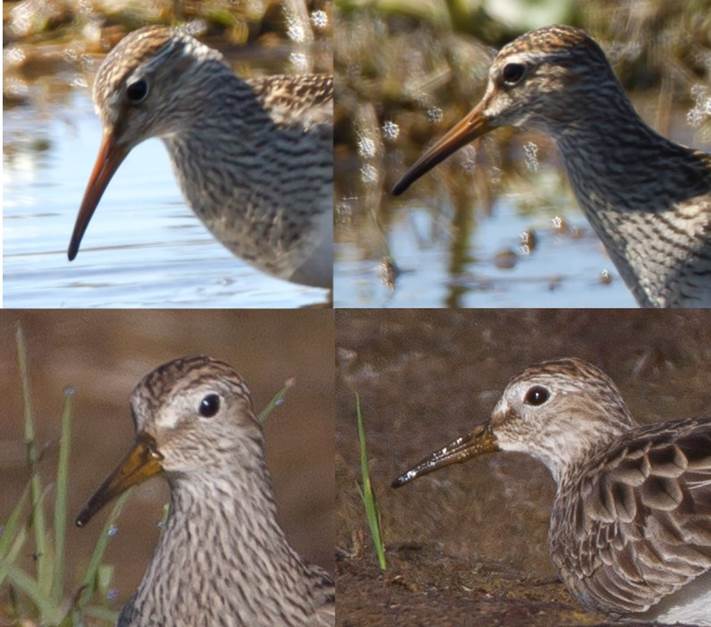It has been confirmed by expert advice that the Pectoral Sandpiper reported in early November was a different bird from the individual that has been present over the last few weeks - in fact different age and sex. I won’t take you over the full graphic analysis but differences are apparent from the heads alone:

Stuart Rae has said:
“The 4th November bird is a bird hatched in 2013. I was going to mention that the bird in Lindsay's shot was an adult, but pulled out as there was no 1st year to compare it with, and such comparative descriptions can be very confusing without evidence before one.
The adult bird has a grey overall wing plumage compared with that of the first year bird's rufous tone. But the categorical feature is the wide buff edges to dark-centred coverts. The bird will gradually lose these during the winter, but retain some of the inner coverts through to the northern spring in 2014. That bird, if it survive to return to its breeding grounds, will probably breed and could be recognised as a one year old bird then by the retention of even one or two buff-edged coverts. Aging of most arctic-breeding sandpipers by this plumage characteristic is a standard technique when catching birds on their breeding grounds.
The first-year bird also has a prominent scapular white V, which is less contrasting in an adult due to the overall less contrasting colouring of the mantle and wing feathers. Do you have a shot showing this more clearly with a comparable pose of the adult?
As for bill length, males have longer bills and as there seems a clear difference between these two birds, I would expect that the larger billed bird is a male and the other a female.
In summing up, the bird seen in November was a 1st year male and that in December was an adult female.”
And later -
“Not quite good enough to tell the difference between the birds' scapular Vs, but if you post these comments on the chat line, perhaps it would be worth showing the two bottom images.
Indeed, on looking at them again, do so. For, they show well the difference in the scapular feathers between ages. The first year bird has well worn, narrow fringes of rufous colouring to the scapular feathers. Note how the fringes have been eroded away at the tips, so that there is no longer any fringe colouring, but those on the sides of the feathers are still wide. Compare this with those on the adult bird. The fresh, newly grown scapular feathers are dark grey centred with light grey fringes, widest at the tips, and there is no abrasion; nicks, chips etc out of the feathers. Only clean edges. In contrast to the secondaries below which show extensive abrasion, they have not yet been moulted.
The colours of the mantle and scapulars are important to the survival of these birds. They need to be 'tundra-coloured' in spring and 'mud-coloured' in winter. So they moult them twice a year. Tundra-breeding waders nest on the ground and it is the head, mantle and scapular feathers which are exposed to any predator. Therefore, the dark base disrupted by pale lines resembles the peat or wet moss with strips of pale weathered grass and sedge stems. They are notoriously difficult to see on the nest. But such contrasting colouring would be readily distinguished on a wide estuary or other expanse of grey mud on their wintering grounds. So, they quickly moult into the grey plumage - which soon bleaches out in the Australian sunshine, which fortunately further enhances their camouflage, as sun-dried mud also goes pale.
Feel free to add to the chatline, and edit to suit. Just credit, LH, GB and SR.”
Danny Rogers added –
“Many thanks for the explanation, all is now clear. I don't think there is much I can add to Stuart's comments - the November bird is a very smart-looking juvenile Pec with a long bill; the December bird is short-billed (so a different individual) in worn adult plumage.
Stuart is probably right about the sexing, but it's not easy. Male Pectoral Sands have longer bills than female, but they are larger birds overall, and the proportionate size of the bill relative to head and body is quite similar in the males and females. I don't think it's a safe sexing feature for Pectoral Sands. But males Pecs are much larger than females and once you've got your eye in, it's usually easy to sex them on a visual assessment of size. It's harder from photos. I agree that the November bird looks big (and hence probably male) while the December bird looks smallish (probably female) by Pec standards, but it's a general impression, not something I could prove systematically.
It's very nice to have both individuals in the same season, but not unknown - it's happened at the WTP a few times (and I once saw a small flock of 6 together). Habitat selection may play a part - I think of Pecs as being more fond of grassy freshwater areas, Sharpies as more tolerant of some brackishness and very open spaces.”
I will send the full-bird shots to anyone who wants to see them

